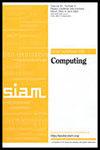数图同态模数的复杂性分类
IF 1.6
3区 计算机科学
Q3 COMPUTER SCIENCE, THEORY & METHODS
引用次数: 0
摘要
SIAM 计算期刊》,提前印刷。 摘要自 Valiant 的开创性工作以来,人们一直在深入研究图同态计数及其广义问题,如计数约束满足问题 (CSP)、计数 CSP 变体以及一般计数问题。虽然图同态精确计数的复杂性 [M. Dyer and C. Greenhill, 2007],但在计算图同态精确计数的复杂性方面却存在着巨大的差距。Dyer and C. Greenhill, Random Structures Algorithms, 17 (2000), pp.A. Bulatov, J. ACM, 60 (2013), pp.J. Faben 和 M. Jerrum,Theory Comput.,11 (2015),pp. 35-57]在他们 2015 年的论文中提出了一个猜想,指出对固定图 [math] modulo 一个素数的同态计数是很难的,除非 [math] 有某类自动态。在本文中,我们证实了这一猜想。作为研究的一部分,我们开发了一些技术,这些技术拓宽了模块计数的还原范围,并适用于一般的 CSP,而不局限于图同态。本文章由计算机程序翻译,如有差异,请以英文原文为准。
Complexity Classification of Counting Graph Homomorphisms Modulo a Prime Number
SIAM Journal on Computing, Ahead of Print.
Abstract. Counting graph homomorphisms and its generalizations such as the counting constraint satisfaction problem (CSP), variations of the counting CSP, and counting problems in general have been intensively studied since the pioneering work of Valiant. While the complexity of exact counting of graph homomorphisms [M. Dyer and C. Greenhill, Random Structures Algorithms, 17 (2000), pp. 260–289] and the counting CSP [A. A. Bulatov, J. ACM, 60 (2013), pp. 34:1–34:41, and M. E. Dyer and D. Richerby, SIAM J. Comput., 42 (2013), pp. 1245–1274] is well understood, counting modulo some natural number has attracted considerable interest as well. In their 2015 paper, [J. Faben and M. Jerrum, Theory Comput., 11 (2015), pp. 35–57] suggested a conjecture stating that counting homomorphisms to a fixed graph [math] modulo a prime number is hard whenever it is hard to count exactly unless [math] has automorphisms of certain kind. In this paper, we confirm this conjecture. As a part of this investigation, we develop techniques that widen the spectrum of reductions available for modular counting and apply to the general CSP rather than being limited to graph homomorphisms.
Abstract. Counting graph homomorphisms and its generalizations such as the counting constraint satisfaction problem (CSP), variations of the counting CSP, and counting problems in general have been intensively studied since the pioneering work of Valiant. While the complexity of exact counting of graph homomorphisms [M. Dyer and C. Greenhill, Random Structures Algorithms, 17 (2000), pp. 260–289] and the counting CSP [A. A. Bulatov, J. ACM, 60 (2013), pp. 34:1–34:41, and M. E. Dyer and D. Richerby, SIAM J. Comput., 42 (2013), pp. 1245–1274] is well understood, counting modulo some natural number has attracted considerable interest as well. In their 2015 paper, [J. Faben and M. Jerrum, Theory Comput., 11 (2015), pp. 35–57] suggested a conjecture stating that counting homomorphisms to a fixed graph [math] modulo a prime number is hard whenever it is hard to count exactly unless [math] has automorphisms of certain kind. In this paper, we confirm this conjecture. As a part of this investigation, we develop techniques that widen the spectrum of reductions available for modular counting and apply to the general CSP rather than being limited to graph homomorphisms.
求助全文
通过发布文献求助,成功后即可免费获取论文全文。
去求助
来源期刊

SIAM Journal on Computing
工程技术-计算机:理论方法
CiteScore
4.60
自引率
0.00%
发文量
68
审稿时长
6-12 weeks
期刊介绍:
The SIAM Journal on Computing aims to provide coverage of the most significant work going on in the mathematical and formal aspects of computer science and nonnumerical computing. Submissions must be clearly written and make a significant technical contribution. Topics include but are not limited to analysis and design of algorithms, algorithmic game theory, data structures, computational complexity, computational algebra, computational aspects of combinatorics and graph theory, computational biology, computational geometry, computational robotics, the mathematical aspects of programming languages, artificial intelligence, computational learning, databases, information retrieval, cryptography, networks, distributed computing, parallel algorithms, and computer architecture.
 求助内容:
求助内容: 应助结果提醒方式:
应助结果提醒方式:


